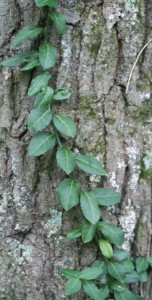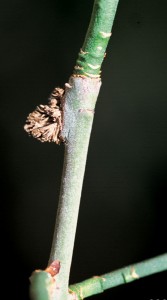Winter Creeper
Euonymous Fortunei
Winter Creeper, Climbing Euonymous, Gaiety, Emerald Gaiety
Native Origin: Introduced from China as an ornamental plant in 1907, Euonymous fortunei and more than a dozen hybrids of the species, remains a popular ornamental vine and ground cover. More than a dozen cultivars have been created and were selected for foliage color, hardiness and growth form. Unfortunately, the very characteristics that make it a “good” garden plant, evergreen and continued photosynthesis in all seasons, ease and rapidity of growth in sun or shade, drought and moisture tolerance, make it a real threat to natural areas.
Description, Habitat & Ecological Impact: An evergreen vine, winter creeper can grow in shrub form, as dense ground-hugging mats, as vines climbing to 70 feet, or in all three forms. Oblong leaves usually are one to two inches long, with slightly toothed edges; all leaf surfaces look and feel somewhat leathery-to-waxy. Stems are greenish to green-gray, slightly warty and carry rootlets or aerial roots. Small green-white flowers are produced in summer, followed by reddish capsules, each containing seeds with their own orange coating. Winter creeper reproduces by seed and vegetatively. Lateral shoots spread from the main stems and new plants also may grow from rootlets produced all along the stems.
Tolerant of poor soil and drought, it grows well and reproduces in all light conditions from full sun to full shade. It out competes native plants by sapping nutrients and moisture and can blanket plants, preventing photosynthesis. Vines can grow up and topple trees and shrubs. Dense vegetative mats can completely replace native flowers, ferns, grasses, sedges, and tree seedlings in woodland and glade areas.
Manual Control: Grubbing out the vines can be effective for small areas and where herbicide use could damage non-target plants or harm wildlife. Pulling and digging when soil is moist aids in removal of all plant parts and roots. All pieces and seeds should be removed to prevent re-rooting. Even where feasible, mowing or cutting of ground-matted populations alone is not effective since remaining stems and roots will resume growth.
Chemical: Foliar application of herbicide can be used. Systemic herbicides, such as glyphosate (Roundup) or triclopyr (Garlon) should be used according to label instructions. Use of a surfactant (wetting agent) generally is needed due to the leathery, waxy leaf surfaces.
Herbicide applied to cut stems may be the best method in areas where foliar spraying would damage wildlife or desirable native plants.
Comments are currently closed.


